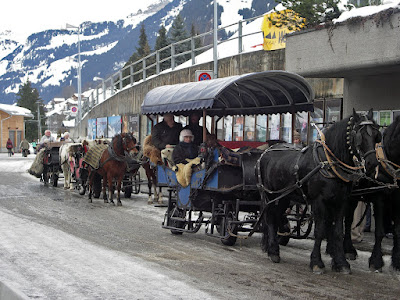
It seemed a good idea way back in the summer. An advert in The Times drew June's attention to a trip to Switzerland over Christmas. After a previous experience when a visit to Interlaken was washed out by floods, we had anticipated a return. A 'real' snowy Christmas in the Bernese Oberland was an attractive possibilty. And so it was arranged.
One advantage of the trip was that it was a no-fly option making use of trains to reach and return from Interlaken. Feeling secure as Christmas approached knowing that the proposed BA strike could not affect us we settled into our packing. Then the news broke that Eurotunnel had run into problems. What happened next will probably ensure that we do not go away again at Christmas. The outward journey was hastily rearranged with a coach from St. Pancras via Ebbsfleet to Dover, ferry to Calais and then over seven hours by coach to Dijon through snow covered countryside and then a fall of heavy snow which made driving difficult. After the exhausting first day things started to improve until we finally arrived in Interlaken.
This is the hotel we stayed in - Hotel Interlaken. Our room was on the third floor, in the centre, overlooking the street. Excellent double glazing ensured that we were never disturbed by noise outside. Good room, good hotel with history but restaurant closed on Sundays and Mondays in winter. But as you can see we seem to have left all the snow in France and England!
Interlaken is an attractive town, especially the older part, Unterseen, and is set between two lakes, the Thuner-see and the Brienzer-see. It is an expensive town by English standards but probably no more so that most of Europe today. But no snow!
Thuner-see was rough and univiting when we took our investigative seven and half mile stroll on Christmas morning.
Deep in the woods we found a ruined medieval castle. This is the view of the lake from the top of the keep.
After a beautiful but snowless walk involving a embarrassing moment with a toilet block, an attractive river walk and a footpath around the near vertical wall of HarderKum, we returned to Unterseen.
Arriving at Grindelwald 3,393 feet. Is that snow I see?
We were promised a sleigh ride! Does that mean we shall be out on snow?
Plenty of ice.
Then we found our first snowy scene in the centre of Grindelwald. Wetterhorn and Schreckhorn behind.
Our sleigh ride took us a viewpoint where we had a welcome glass of glühwein and watched the lights come on in Grindelwald below.
On Boxing Day we took the train from Interlaken via the Lauterbrunnen Valley, Wengen, Wengenalp, Kleine Scheidegg and through the EigerTunnel to Jungfraujoch - Top of Europe. It was a spectacular day and this is the view looking NW from the observation platform at the top, 3454m.
Looking SE over Jungfraufirn to the Aletsch Glacier.
The Jungfrau 4158m (13,642 ft).
The Monch 4107m.
June ventures into the ice palace.
Deep in the ice figures like these penguins had been carved forming discrete tableau.
From Jungfruajoch far below we could see Mannlichen which we had planned to visit on the morrow if the weather held. The little figures indicate our intended route to the summit view point from the cable car station.
Our ascent of Mannlichen began at the heavily commercialised mountain resort of Wengen.
We needed to take the cable car (ringed) to the Mannlichen Station, also ringed and then make our way along the ridge to the left.
Arriving at Mannlichen Station
Leaving time for the hordes of skiers to zip off, we prepared ourself for our walk to the Mannlichen view point. The snow was surprisingly easy to walk on and inspite of the fact that it was a bit of an uphill struggle, we made good time. When we reached the top the views were simply amazing.
Looking east we see Grindelwald nestling in its valley with Wetterhorn behind, Schreckhorn and the lower slopes of the Eiger on the right.
To the southwest is the deeply U-shape of the Lauterbrunnen Valley with Grimmelwald and Murren on their 'alps' above the valley floor, just right of centre. The mountains are from left to right - Grosshorn 3754m, Breithorn 3782m, Tschingelhorn 3557m and Gspaltenhorn 3437m.
Looking south we could see the north face of the Eiger overlooking our route from the Mannlichen Restaurant, middle right-hand side. Just seen is the observatory in the col to the right of the Monch where we were yesterday.
Back down at the restaurant we could get a closer look at the three famous peaks. From left to right - Eiger, Monch and Jungfrau. In the foreground is Tschuggen behind which lies the station at Kleine Scheidegg.
Remagen has many beautiful and well-maintained buildings, churches, castles, and monuments. It also has a sizeable pedestrian zone with plenty of shops.
The Ludendorff Bridge (or Bridge at Remagen) was originally built during World War I as a means of moving troops and logistics west over the Rhine to reinforce the Western Front. The bridge carried two railway tracks and a pedestrian walkway. During World War II, one track was planked over to allow vehicular traffic. It was the last bridge standing on the Rhine when captured by soldiers of the U.S. 9th Armored Division on 7 March 1945. Although German engineers had mined the bridge before the American approach, the fuses had been cut by two Polish engineers and the bridge was captured intact. After subsequent German bombing and mining it finally collapsed 10 days later.
And then we went home!





























